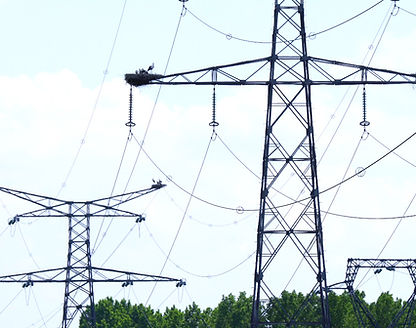
Improving & Sharing Knowledge
What is the context?
Given the limitations of carcass research and mortality data in these large areas, the impact of the lines is largely underestimated and therefore, in addition to the difficulty to identify responsible lines, insufficiently resolved.
The lack of data and knowledge due to difficulties in monitoring bird electrocutions and collisions (e.g. non-standardisation in data collection, difficulties on carcass recovering or determining the exact cause of death) is a major obstacle to accurately estimate the effect of power lines on birds and the effectiveness of mitigation measures.

© RGI

© James Dwyer
Secondly, engagement with all relevant actors is crucial for improving bird protection along the grid. Collaboration facilitates the exchange of valuable insights, experiences, and best practices, leading to the development and implementation of effective protective measures.
This collaborative effort not only enriches the pool of knowledge but also strengthens the commitment of all involved parties, promoting sustainable practices and driving the successful implementation of bird protection measures along the electricity grid.
What are the project actions?
The project aims to offer comprehensive insights into the interactions between birds and electricity grid infrastructure, aiming to gather a wealth of data and knowledge. To achieve this, we will compile information and experiences from European grid operators and environmental NGOs on a unified European platform. All collected data will be managed transparently and openly, accessible through the SafeLines4Birds digital platform. This approach streamlines the dissemination of knowledge concerning technical innovations and equipment throughout Europe, fostering the potential replication of successful initiatives in other countries.
_edited.jpg)
© RTE
%20(2)_edited.jpg)
Additionally, our partners in France and Belgium will collect important data on the Black Stork, a species whose interactions with power lines are not yet well understood. Thanks to this innovative initiative, high-risk areas for the species will be identified. This will be achieved through a large-scale tracking of juvenile Black Storks contributing to the advancement of scientific data production, collection, and open sharing to better understand and mitigate the impacts of electricity infrastructure on vulnerable bird species.
By equipping 84 young Black Storks with GPS tags in France and Belgium in 2024 and 2025, the project has generated datasets that will help inform conservation and grid safety measures across Europe. The resulting data will reveal how juveniles interact with power lines during critical life stages: dispersal, rest, and migration. A systematic study of their movements will help identify specific electrocution and collision hotspots, particularly near medium-voltage poles in forest edges, wetlands, and open landscapes. Watch the video below for more information on this action in France.
Along short-term conservation actions, the project also builds long-term scientific understanding of Black Stork ecology, including movement dynamics and habitat use. As an umbrella species, insights gained will benefit other large birds with similar ecological traits, such as the White Stork, Osprey, Egyptian Vulture, and Bonelli’s Eagle.
Finally, diverse communication channels will be utilised to share results and knowledge, targeting not only the general public but also engaging various stakeholders, including civil society, grid operators, and regulatory bodies. Various of events have been organised by our partner Renewables Grid Initiative (RGI), such as ‘Connecting Biodiversity’ workshops and Wingspan 2024, to gather insights from diverse stakeholders, facilitating the replication of successful actions and promoting enhanced collaboration between environmental NGOs and grid operators across Europe and beyond.
What are the tools?
An Open-Source Application for Diagnosing and Monitoring Electric Poles and Wires
Thanks to the collaboration between our partners Enedis (French DSO) and nature conservation organisations (including the LPO France), the application "Avifaune & Câbles" was created. It supports the collection of data on bird mortality, provides precise and up-to-date monitoring of the condition of the lines and help identify dangerous electric poles and power lines throughout France. Moreover, this application offers significant assistance for the coordination of mitigation efforts among various stakeholders, and include reports of regular site visit, diagnostics of power lines and details of planned or past retrofitting efforts.
The "Avifaune & Câbles" application was originally developed by the Vanoise National Park, as part of their agreement with Enedis and the Savoie Department, and was later expanded to Haute-Savoie through the LIFE Gyphelp project in 2015. In 2016, this initiative was further extended across the Northern Alps with the involvement of various local stakeholders, such as national parks, regional parks, departments, local LPO, Enedis..
Given the clear added value of such a tool for consolidating information from multiple actors, the application was incorporated into our project and has since been further developed and enhanced by our partner LPO Auvergne-Rhône-Alpes.
A Scientific Database to Collect and Share Knowledge
As part of this project, our partner RGI developed a scientific database to collect studies on the topic of bird protection along the electricity grid and effectively disseminate knowledge among a wide range of stakeholders.
What is the SafeLines4Bird database?
-
A centralised, searchable webpage collecting scientific studies, technical reports, and grey literature on bird collision and electrocution issues along power lines.
-
A tool to support evidence-based decision-making for researchers, infrastructure managers, conservationists, and policymakers.
-
A growing, collaborative platform to enhance understanding of the issue and improve conservation outcomes across Europe and beyond.


.jpg)
